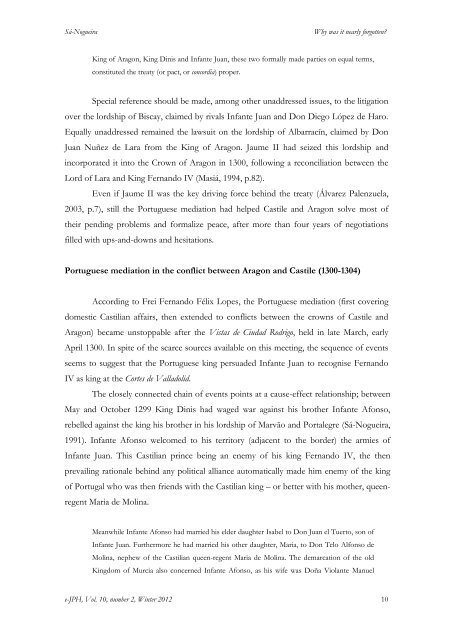Why was it nearly forgotten? The Agreda Treaty ... - Brown University
Why was it nearly forgotten? The Agreda Treaty ... - Brown University
Why was it nearly forgotten? The Agreda Treaty ... - Brown University
You also want an ePaper? Increase the reach of your titles
YUMPU automatically turns print PDFs into web optimized ePapers that Google loves.
Sá-Nogueira<br />
<strong>Why</strong> <strong>was</strong> <strong>it</strong> <strong>nearly</strong> <strong>forgotten</strong>?<br />
King of Aragon, King Dinis and Infante Juan, these two formally made parties on equal terms,<br />
const<strong>it</strong>uted the treaty (or pact, or concordia) proper.<br />
Special reference should be made, among other unaddressed issues, to the l<strong>it</strong>igation<br />
over the lordship of Biscay, claimed by rivals Infante Juan and Don Diego López de Haro.<br />
Equally unaddressed remained the lawsu<strong>it</strong> on the lordship of Albarracín, claimed by Don<br />
Juan Nuñez de Lara from the King of Aragon. Jaume II had seized this lordship and<br />
incorporated <strong>it</strong> into the Crown of Aragon in 1300, following a reconciliation between the<br />
Lord of Lara and King Fernando IV (Masiá, 1994, p.82).<br />
Even if Jaume II <strong>was</strong> the key driving force behind the treaty (Álvarez Palenzuela,<br />
2003, p.7), still the Portuguese mediation had helped Castile and Aragon solve most of<br />
their pending problems and formalize peace, after more than four years of negotiations<br />
filled w<strong>it</strong>h ups-and-downs and hes<strong>it</strong>ations.<br />
Portuguese mediation in the conflict between Aragon and Castile (1300-1304)<br />
According to Frei Fernando Félix Lopes, the Portuguese mediation (first covering<br />
domestic Castilian affairs, then extended to conflicts between the crowns of Castile and<br />
Aragon) became unstoppable after the Vistas de Ciudad Rodrigo, held in late March, early<br />
April 1300. In sp<strong>it</strong>e of the scarce sources available on this meeting, the sequence of events<br />
seems to suggest that the Portuguese king persuaded Infante Juan to recognise Fernando<br />
IV as king at the Cortes de Valladolid.<br />
<strong>The</strong> closely connected chain of events points at a cause-effect relationship; between<br />
May and October 1299 King Dinis had waged war against his brother Infante Afonso,<br />
rebelled against the king his brother in his lordship of Marvão and Portalegre (Sá-Nogueira,<br />
1991). Infante Afonso welcomed to his terr<strong>it</strong>ory (adjacent to the border) the armies of<br />
Infante Juan. This Castilian prince being an enemy of his king Fernando IV, the then<br />
prevailing rationale behind any pol<strong>it</strong>ical alliance automatically made him enemy of the king<br />
of Portugal who <strong>was</strong> then friends w<strong>it</strong>h the Castilian king – or better w<strong>it</strong>h his mother, queenregent<br />
Maria de Molina.<br />
Meanwhile Infante Afonso had married his elder daughter Isabel to Don Juan el Tuerto, son of<br />
Infante Juan. Furthermore he had married his other daughter, Maria, to Don Telo Alfonso de<br />
Molina, nephew of the Castilian queen-regent Maria de Molina. <strong>The</strong> demarcation of the old<br />
Kingdom of Murcia also concerned Infante Afonso, as his wife <strong>was</strong> Doña Violante Manuel<br />
e-JPH, Vol. 10, number 2, Winter 2012 10
















